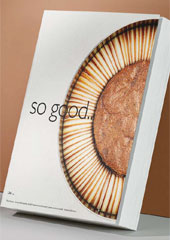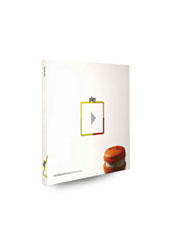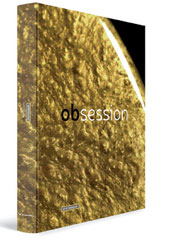Articles
Lima's Best Ceviche
South America's new raw fish culinary Capital
News - Articles

PERU'S CHAOTIC CAPITAL has become the culinary center of the Americas-and little surprise, given its sprawling
food festival, Mistura; homegrown celebrity chefs like Gaston Acurio and Rafael Osterling;
and Spanish, African, Asian and Pre-Colombian influences.
The city's causas (mashed yellow potatoes layered with fillings) are irresistible and the anticuchos,
roasted beef-heart skewers, are as tender as filet.
But the heart of contemporary Peruvian cuisine is a light, tangy tradition that isn't even
technically cooked: ceviche.
The dish mainly consists of the freshest of fish marinated in acidic liquids that "cook" it by changing the proteins in the flesh, making it firm and opaque.
And its evolution reveals the country's history in ways few others can.
When the Spanish first made contact with Peru in the 16th century, they found coastal communities eating raw fish steeped in tumbo, a type of passion fruit.
"When the Spanish came, we started using limes and sour oranges, which we would [leave the fish in] for hours to let the acid enter into the skin," said Jaime Pesaque,
chef and owner of the Lima restaurant Mayta.
In the 1970s, Japanese chefs in Lima began experimenting with ceviche, marinating the fish for just a few minutes.
"The Japanese had a really great influence on our ceviche," Mr. Pesaque said. "They showed us how to treat fish, eat fish raw and... cut the fish into perfect squares."
Classic ceviche preparations are a mix of fish, salt, red onions and aii, Peru's unique line of chili peppers, all doused in lime juice.
(The marinade is called leche de tigre, or tiger's milk.) Yellow potatoes or yams, native to Peru, also may be included.
But simple doesn't necessarily mean easy: Ceviche preparation is an art, much like the making of ramen in Japan. Fish that sits too long in acid can
taste "overcooked." The size of the fish pieces affects how long they should marinate. Many chefs spend years perfecting their recipes,
learning to slice particular fish a certain way and toss it with precise proportions of ingredients in a unique motion for a specific amount of time.
While the best ceviches in Lima have long come from masters working in humble neighborhoods - such as Javier Wong in gritty La Victoria and Sonia
Bahamonde in the coastal district of Chorrillos a younger generation of chefs is bringing new ideas to the table, changing the types of seafood
being used and even the time of the day the dish is eaten.
Peru's Pacific coastline is at the confluence of the Humboldt and Equatorial Counter currents, with warm water in the north and cold water in the south,
a recipe for great marine diversity. Yet the favored varieties for ceviche, including sea bass, sole and shellfish, are increasingly scarce and expensive.
"There has been a depredation of marine resources," said Mariano Valderrama, vice president of APEGA, Peru's association of gastronomy.
"Boats that draw fish for the fishmeal industry invade artisanal fishing zones. There are those who fish with dynamite."
Jose Lopez de la Fuente began offering sustainable seafood at his concept store/cevicheria, La Pescaderia, in the port neighborhood of Callao in 2008,
opening a second location in Barranco in 2011. The restaurant began as an experiment in serving less-popular species of seafood, such as marlin,
sailfish and shark, which were the by-catch of tuna fishing boats. Other chefs took notice and are finding that diners are willing to try ceviche with
unfamiliar fish.
Traditionally, cevicherias were lunch establishments - before reliable refrigeration, fish eaten at night would have sat out all day. Today,
few Lima restaurants serve fish that was caught that morning and rely far less on artisanal fishermen, so many top cevicherias are open at night.
Still, whether they are in coastal beach shacks or rubber-boom-era buildings in the Amazon, cevicherias really fill up on the weekends, when a visit
becomes an all-day affair with friends and family. Some things may change, but clearly Peruvian grandmothers are still holding out.
The Icon: Sonia
Rustic Sonia, decorated with fishing nets and anchors, has been open for 33 years and features three generations of one family in the kitchen.
"We could open a second restaurant, but it wouldn't have the same spirit," said general manager Roberto Guardia Bahamonde. The concept grew from the simple recipes
Sonia Bahamonde used to cook for fishermen while her husband, Fredy Guardia, was out at sea. The restaurant is credited with developing the a la chorrillana
(garlic and onion) and a lo macho (spicy seafood) sauces, now nationally known. You cannot go wrong with the Cebiche de la Casa, a mix of shrimp,
octopus, sole and crabmeat, shown above. Santa Rosa 173, Chorrillos,
restaurantsonia.com
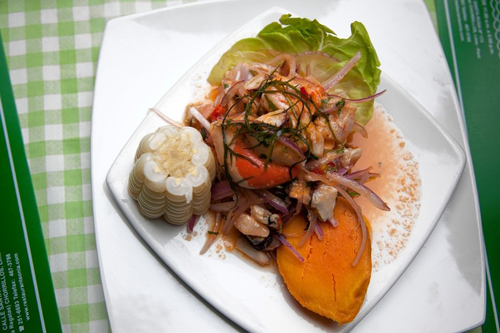
Cebiche de la casa at Sonia
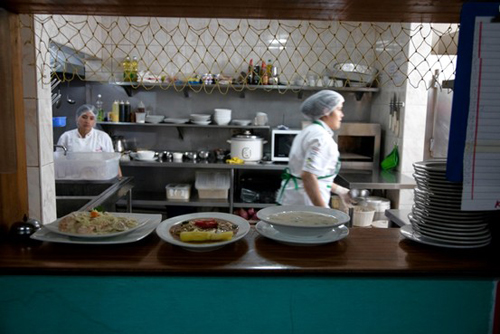
Dishes leaving the kitchen at Sonia
The Trendsetter: El Mercado
After Gaston Acurio, no Peruvian chef has built a restaurant empire larger than that of Rafael Osterling, who has outposts as far away as Colombia.
El Mercado, his beachy second restaurant in Lima, has a market-style atmosphere. It serves chalkboard specials in addition to a massive menu of Peruvian coastal
classics, and dishes influenced by Asian and Mediterranean food, such as a fried ceviche and causa, a layered potato casserole, rolled to look like sushi.
Hipolita Unanue 203, Miraflores,
rafaelosterling.com

Rafael Osterlings - El Mercado
The Back-to-Basics Spot: Los II Piratas
This small restaurant with peeling turquoise walls has inspired cevicherias around the country. Opened in 1998, Los II Piratas specializes in using tramboyo,
an inexpensive type of rock fish. Normally ceviches don't include such a small fish, but the right amount of salt and lime works wonders - which is why the eatery took first
place in Mistura's ceviche category in 2009. Other tasty options include mussel ceviche (left). Jr. Arturo Suarez 298, San Juan de Miraflores,
losdospiratas.com
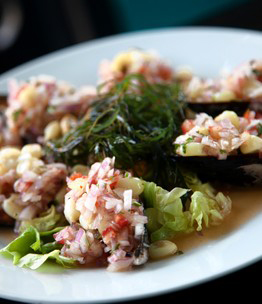
Mussel cheviche at Los Piratas
The Eco Eatery: La Pescaderia
This concept cevicheria and fish market began near the port of Callao; an elegant second location, with high ceilings and ornate tile floors,
opened in a historic Barranco building in late 2011. The menu was designed by chef Pedro Miguel Schiaffino, and incorporates his philosophy of using obscure foods - think
marlin, smoked in-house and served on a butifarra (a sandwich topped with onions); or sea snails seasoned with soy sauce. A yellow aji tiradito (left)
is a more traditional pick. Avenida Grau 689, Barranco,
lapescaderia.pe
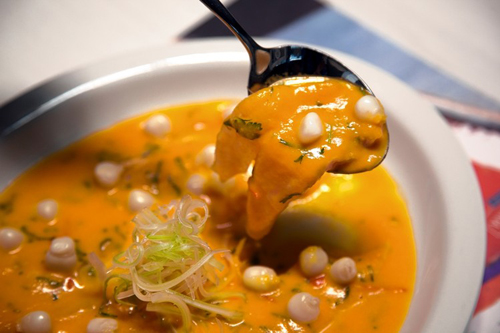
A yellow aji tiradito from Pescaderia

Cebiche Carretillero based on a recipe found in food stalls in Lima at Pescaderia
The Iconoclast: Chez Wong
Javier Wong has said that having a menu at his restaurant in gritty La Victoria neighborhood would be akin to wearing a condom on his ideas.
The simple eatery is in the chef's house, has no sign and can only be visited with a reservation. Diners eat what the chef serves - usually one of his
signature sole ceviches, mixed with squid or octopus, followed by a saltado (Peruvian stir fry), served sweet or salty. If you want something else
or fish prepared in a different way, you'll have to go elsewhere. Enrique Leon Garcia 114, La Victoria, 470-6217
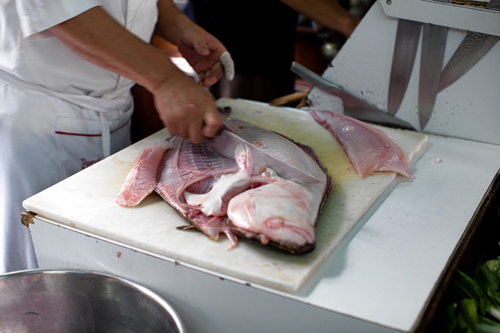
Javier Wong cuts an entire sole to be used in ceviche
The Favorite: Pescados Capitales
Avenida La Mar in Miraflores is Lima's ceviche hub, with a dozen or so establishments around the otherwise unappealing street. The best on the strip
is Pescados Capitales, with its open-air setting, minimalist decor and menu organized by deadly sins ("pecados capitales"). It serves precisely executed
versions of typical ceviche plates, plus a few that stray from the norm, like Cebiche Gandhi, which flavors chita (grunt), squid and shrimp with curry, mango,
peach and mushrooms. Cooked dishes such as grilled octopus (left) are also on offer. Avenida La Mar 1370, Miraflores,
pescadoscapitales.com
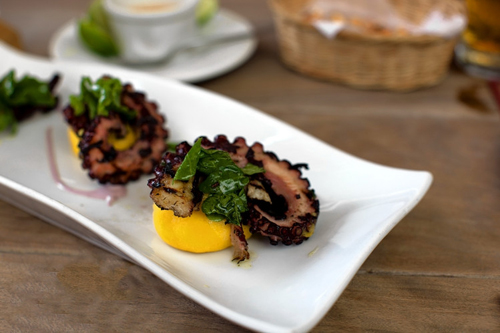
Grilled octopus at Pescados Capitales
The Melting Pot: Nikko
In recent years Nikkei food Peruvian - Japanese fare has been all of the rage in Lima. Nikko, a slick two-level spot in the upscale suburb of La Molina,
is one of Lima's first Nikkei-specific cevicherias. The lengthy menu includes a long list of sashimi-thin tiraditos, ceviche-like dishes that douse raw
seafood in aji-spiced sauces, as well as tempuras sided by tentsuyu sauce and sushi. Of the half dozen ceviches on the menu, the best may be the Seviche Nikkei,
a combination of tuna and octopus spruced up with tamarindo. Avenida La Fontana 1137, La Molina,
www.nikko.com.pe
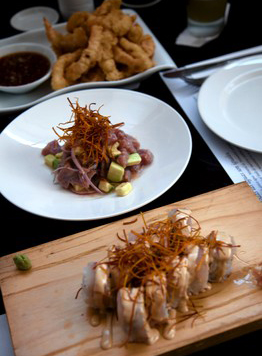
A variety of Nikkei or Japanese-Peruvian fusion plates at Nikko
By NICHOLAS GILL
Source: online.wsj.com



